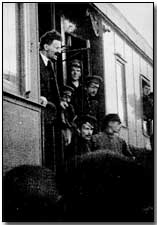Primary Documents - Russo-German Armistice, 16 December 1917
 Reproduced below is the
text of the preliminary armistice agreed by Bolshevik Russia and Germany in
December 1917. This followed a
formal statement by Trotsky
in late November in which he outlined Russia's intention to seek an early
armistice.
Reproduced below is the
text of the preliminary armistice agreed by Bolshevik Russia and Germany in
December 1917. This followed a
formal statement by Trotsky
in late November in which he outlined Russia's intention to seek an early
armistice.
Click here to read a memoir recounting the initial armistice discussions. Click here to read Leon Trotsky's report on the progress of armistice negotiations; click here to read the official German view. Click here to read the text of the subsequent Brest-Litovsk peace treaty.
Russo-German Armistice, 16 December 1917
Between the representatives of the higher command of Russia on the one hand and of Bulgaria, Germany, Austria-Hungary, and Turkey on the other hand, for the purpose of achieving a lasting and honourable peace between both parties, the following armistice is concluded:
The armistice shall begin on December 17th at 2 o'clock in the afternoon and continue until January 14th. The contracting parties have the right to break the armistice by giving seven days' notice. Unless notice is given the armistice automatically continues.
The armistice embraces the land and aerial forces on the front from the Baltic to the Black Sea and also the Russo-Turkish front in Asia Minor. During the armistice the parties concerned obligate themselves not to increase the number of troops on the above fronts or on the islands in Moon Sound, or to make a regrouping of forces.
Neither side is to make operative any transfers of units.
Source: Source Records of the Great War, Vol. V, ed. Charles F. Horne, National Alumni 1923
Russia mobilised 12 million men during the war; France 8.4 million; Britain 8.9 million; Germany 11 million; Austria-Hungary 7.8 million; Italy 5.6 million; and the USA 4.3 million.
- Did you know?
